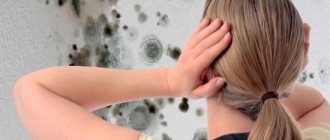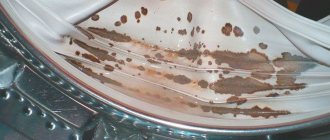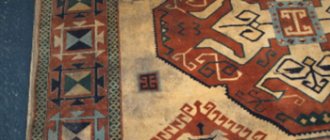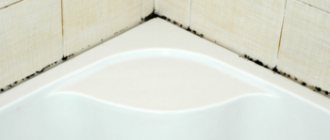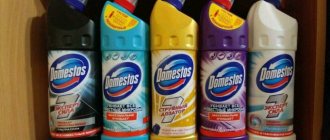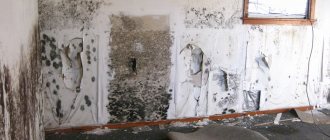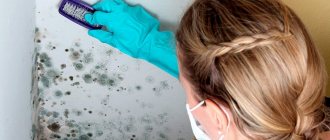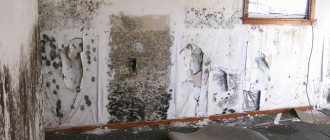Mold is one of the worst household enemies. It can appear in any room, even if all preventive measures are taken. If an outbreak appears, the fungus quickly grows and affects more and more new areas.
Why is mold so dangerous? Firstly, the fungus on the walls does not look very aesthetically pleasing, secondly, an unpleasant odor appears, and thirdly, the spores of this fungus are very harmful to humans. That is why it is important to start the fight as soon as the first darkening is noticed. And for this, products such as soda and vinegar can be used.
Using hydrogen peroxide
The simplest method is to treat the affected surface with a 3% hydrogen peroxide solution, which can be purchased at any pharmacy. It is better to repeat the procedure several times. You can wipe the surface with a cotton swab dipped in the solution, or use a spray bottle.
You can buy a 3% peroxide solution at any pharmacy; its smell is not so harmful to humans, so it is convenient to work with.
Peroxide is one of the best antibacterial agents, but it must be stored in a dark place in a dark glass bottle with an airtight stopper. Otherwise, this chemical compound will split into oxygen and water, losing its universal properties.
It must be applied to a prepared surface free of mold.
During work, safety precautions should be observed, and before processing begins, you must put on glasses on your eyes, a mask or gauze bandage on your face, cover your head, and take gloves.
We use ammonia
Another means of combating fungal infections is ammonia. It is used both pure and diluted with ordinary water in a 1/1 ratio. However, this method is only suitable for flat and smooth surfaces of tiles, glass or plastic. The surface is treated with a cotton pad soaked in the solution.
It does its job perfectly when mold has formed, for example, on tiles or glass.
You should take into account the fact that ammonia has a rather pungent odor, so it is better to carry out the cleaning procedure in a well-ventilated area.
Killing mold with baking soda
Fungi cannot reproduce in an alkaline environment, so a regular baking soda solution is an excellent remedy for mold on walls and other surfaces in the apartment. This option is ideal for those who cannot tolerate strong odors and are sensitive to toxins.
Baking soda is one of the easiest and safest ways to get rid of mold, and it does not harm either humans or pets.
For the procedure, a glass of water and one teaspoon of soda are enough. It can be repeated several times, depending on the degree of damage to the surface. Apply the product with a sponge, small rag or use a spray bottle. After treatment, the solution does not even need to be washed off.
After an hour, the surface should be washed with water, but it is not recommended to completely wash off the soda solution from it.
What types of mold exist, and what harm do they cause to human health?
There is a huge variety of molds. Each of them poses a danger to human health. By constantly staying in a house infected with fungus, you can acquire chronic diseases.
The most common types of mold that often “settle” in a residential building:
Black. Most often this is the type that appears on the walls. Can appear on any type of surface. Concrete, plaster, wallpaper, paint, and wood are equally easily affected.
Wall affected by black rot
Why it is dangerous: with constant exposure to the human body, it can cause dizziness, sleep disturbance, and insomnia. Headaches are common, and body temperature may rise. The worst option is dermatitis or the development of diseases of the respiratory system: bronchitis, asthma, pneumonia and even lung cancer.
White. It appears in the apartment mainly in flower pots. Appears on walls in rare cases. Excessive watering or the application of certain fertilizers can provoke the development of fungus.
Wall affected by white rot
Why it’s dangerous: less harmful option than the previous one. But if you do not fight this “pest,” it can provoke the development of allergic reactions in humans.
Blue mold. Settling in wood fiber, it affects wooden surfaces: frames, parquet, wooden furniture. Under their influence, the tree acquires an unattractive bluish-gray tint.
Tree affected by blue rot
Why it is dangerous: the fungus destroys the paintwork and forms microscopic channels in the wood. Water gets into them, increasing the moisture content of the wood. This creates more favorable conditions for mold to grow.
Green. Most often it develops on food products. It can often be seen on bread. Occasionally it develops on building materials, for example, on brick.
Wall affected by green rot
Why it is dangerous: fungal spores, once in the human body, are digested by the gastrointestinal tract and excreted from the body. If the immune system is weak, the spores enter the bloodstream and cause serious illness. Among them: liver cirrhosis, bronchial asthma, benign and malignant formations.
Mold rotting. Like blue rot, it affects wooden surfaces. A characteristic sign that rotting mold is developing in wood is a gray or brown tint to the top layer of wood products.
Wood rotting
Why it is dangerous: after exposure to this fungus, the wood becomes lighter and becomes covered with cracks. In the most advanced cases, a complete replacement of wooden surfaces is required: frames, floor boards, parquet, furniture.
We use bleach
Household chemicals with a whitening effect are not natural, however, they are quite affordable. It should be borne in mind that these products are quite aggressive, so they are diluted with water. The dilution method and proportions are indicated in the instructions on the bottle or at the rate of 1/10.
Bleach is great for glass, tiles, bathtubs, and other non-porous materials, but is powerless for drywall and wood.
It is very important to think about protecting the skin and mucous membranes. It is better to carry out the cleaning process in a well-ventilated area. The solution is applied to the walls using a stiff brush. The procedure can be repeated again, and then thoroughly clean the surface.
Causes of mold in an apartment or house
Mold on walls can appear for various reasons. Having dealt with them, it is easy to understand how to get rid of the problem that has arisen.
- Poor ventilation. In well-ventilated rooms, the air “pulls” spores out of the room and prevents them from settling on surfaces. In the corners of rooms, ventilation is poor, so mold is often found there. The best solution to the problem is to install an air conditioner in the room. If this is not possible, you need to ventilate the air in the house more often.
- Freezing of walls. The first sign that mold has appeared for this reason is the appearance of a dark coating in the corners and at the joints of the walls. The outer wall froze, and inside, under the influence of heat, it turned into more moisture, which became the habitat of the fungus. The walls must be thoroughly dried, the surface of the walls and corner joints examined, and the adhesion of the plaster checked.
- Dampness from the ground. If the reason lies in this, then its consequence is drips that form at the bottom of the wall, at the joints of the floor. In this case, it is necessary to check the horizontal insulation of the foundation walls.
- Leaking water pipes. The problem is caused by high humidity. The appearance of mold in such conditions is a common occurrence. To fix the problem, you need to replace the damaged pipes.
Mold in the house, what causes it? Roof leaks, poor room heating, increased thermal conductivity of corners, leaking gutters and drains - all this can provoke its development inside houses and apartments.
Using borax
An effective folk remedy in the fight against fungi and mold. It is not dangerous to human health, is a natural product and simultaneously acts as a herbicide, insecticide and fungicide.
Borax is a natural material, so it cannot harm human health.
The process begins by cleaning the surface of mold with a damp cloth. Then the wall or plane is wiped with a stiff brush with a solution, which is prepared as follows: add 1 cup of borax to 2.5 liters of water. Then the wall is wiped with a dry cloth.
There is no need to wash the solution. Borax is often used to clean drains and toilets.
How can you get rid of the smell?
If, after destroying the mold, the corresponding smell remains, this can only mean that the fungus was not completely removed.
To eliminate unpleasant odors, you can use special chemicals (anti-mold impregnations, antiseptics). Folk remedies will also help.
Great for eliminating unpleasant odors:
- lemon juice or acid;
- vinegar;
- bleach;
- washing powder.
These products are used to moisten a cloth or sponge and wipe the problem areas.
The problem can be solved with the help of copper sulfate, but it is used only where it is not able to be absorbed. Essential oils, such as grapefruit or tea tree oil, are excellent at removing mold odors .
Find out more about mold odor control here.
Citric acid
To combat, use citric acid or lemon juice, which affects mold in the same way as vinegar. Weak organic acid negatively affects the development of bending.
Citric acid is a weak organic acid that negatively affects the development of fungus.
To prepare the solution you need 1 glass of water and 1 teaspoon of acid or juice. Use the resulting solution to clean the surface and do not rinse it off.
This is an ideal way to clean tile surfaces and tile joints.
Are such methods effective?
Both soda and vinegar are seriously inferior to commercially available special products in terms of effectiveness. They can cope if the mold spores have not yet grown widely enough and have not penetrated deep into the finishing materials.
If mold appears again 1-3 weeks after treatment, it means that vinegar or soda were not effective enough, and it is recommended to use special products.
Why is mold on a mattress dangerous, and is it possible to remove it?
How to use copper sulfate against mold: instructions
Related Posts
Vinegar
There is an opinion that table vinegar is one of the best folk remedies for removing fungal infections in the bathroom and other rooms on your own.
However, this method is not suitable for everyone, since vinegar has a rather pungent odor and can adversely affect the health of allergy sufferers.
Regular vinegar is an acid that is poisonous to many types of mold.
The room should be well ventilated. Vinegar is applied with a cloth and wiped over the surface, or sprayed from a spray bottle (in this case, you should consider protecting your face and eyes). After treatment, the surface is washed with water and the room is left to ventilate.
Prevention
To avoid secondary infection with this parasite, it is advisable to take preventive measures:
- Set up ventilation. This can be done through ventilation.
- Take action against freezing of premises and accumulation of condensation in them.
- Repair minor leaks. They are a constant source of moisture.
- Get rid of cast iron pipes. It is better to use plastic ones, as they do not contribute to the formation of condensation.
- Do not dry wet laundry in the rooms.
- Treat the joints between tiles in a timely manner.
Grapefruit Seed Extract
The product resembles tea tree oil, is inexpensive, has an excellent smell and disinfectant properties. Preparation of the solution: dilute 10 drops of extract in a glass of water. It must be sprayed and not washed off so that the properties protect the surface from new lesions.
We use a sprayer for application, and after application we do not wash off the solution, since the longer it comes into contact with the damaged surface, the better.
Processing protection measures
To protect yourself from the harmful effects of the products used, as well as the fungus itself, you should prepare for the procedure in advance:
- wear gloves, goggles, a respirator;
- Use a rag, sponge, sandpaper, brush, water container, or garbage bag while working.
When using any product described in the publication, be extremely careful not to spread mold spores throughout the house and prevent re-contamination of surfaces.
Stationery glue
Folk wisdom has no boundaries. Craftsmen have learned to get rid of fungus even with the help of ordinary office glue. The solution is prepared by diluting glue with water in a ratio of 1/1.
This method will remove only minor fungal damage to the surface.
The solution is applied to the surface several times, using a brush, without removing.
Hydrogen peroxide, boric acid and vinegar
Such a vigorous mixture allows you to remove fungus in the apartment both on the walls and on other surfaces at the highest level. All components should be combined with water in a ratio of 4:2:2:1, where 4 parts are water, 1 – vinegar, 2 – peroxide and boric acid.
The resulting solution is sprayed onto the surface several times and not washed off. The procedure should be carried out in a ventilated area, and consider protecting the face, eyes, mucous membranes and hands.
All these components are able to cope with mold at the highest level, and together they give an absolutely amazing effect.
Sometimes simply treating the stain with a solution is not enough to remove mold. Such methods are appropriate at the initial stage of manifestation of the fungus. More serious damage requires removing wallpaper or plaster, and treating the wall with building solutions that destroy not only fungi and mold, but also moss, yeast and algae. They are characterized by high fungicidal properties and deep penetration.
Mold in each room has its own characteristics, so the approaches to combating it should be slightly different.
To prevent the recurrence of the fungus, you should follow some rules:
- carry out prevention with antifungal detergents;
- wash walls more often and wipe dry in wet areas;
- organize good ventilation and ventilation;
- do not skimp on heating: the room must be dried, especially in the cold season;
- leave the bathroom door open;
- seal cracks around windows and consider additional wall insulation.
If you have already gotten even with all traces of the raid, then the next step is to prevent it from appearing again.
The most important thing is compliance with preventive measures:
- regular cleaning;
- ventilation and airing;
- high-quality heating and thermal insulation.
After removing mold, sometimes it is not possible to get rid of the smell so quickly. Here, ordinary soda, placed around the room in small containers, or charcoal briquettes can come to the rescue. After some time, they will absorb unpleasant odors.
Baking soda perfectly absorbs odors, so after this procedure the smell will either disappear or become much weaker.
The capabilities of mold are often underestimated, and it must be dealt with at the first minor manifestations. At the same time, the most important thing is to find and eliminate the root causes of its appearance and spread, otherwise all efforts may be ineffective. However, you should not despair, because you can always find the ideal protection option.
So, for example, in the bathroom the most vulnerable are the joints between the tiles and the plumbing. They quickly develop a black coating that is not washed off - this is mold. In this situation, clean the seams with a metal scraper, and then reapply grout with antiseptic properties and sealant.
You can also get by by applying a solution of bleach, soda, vinegar or tea tree to the affected area in the bathroom.
If mold has formed on the ceiling, you need to moisten the surface with water, wait a while until it softens, and then remove the whitewash and plaster with a spatula. Next, treat the surface with an antifungal agent and apply a primer, which also contains antifungal agents. After it dries, a penetrating primer is applied, and you can begin further finishing of the ceiling.
For minor manifestations of fungus, you can use solutions of bleach, tea tree, soda or vinegar to treat the ceiling.
The most difficult question is how to get rid of mold on wallpaper. In rare cases, it is possible to preserve them without spoiling the color and preserve the design.
At the initial stages, solutions made from soda, ammonia or vinegar will help.
If the walls are painted, then mold is more likely to spread over the surface of the paint, so it will be enough to remove only the paint coating, and then proceed with serious means of protection against fungi.
It will be more difficult to get rid of troubles on plasterboard walls or ceilings. Gypsum has a porous structure, which is very conducive to the spread of spores into the material. Therefore, in this situation, you should remove the cardboard layer, and then proceed to remove the inner plaster. After which everything is treated with special means, a solution and a deep penetration primer, and then, after drying, everything is sealed with gypsum mortar.
It must be taken into account that mold can develop deep into the material. In this case, professional products are suitable.
If you do not fight the initial manifestations of fungus, after 10-12 months the mold will eat not only plaster or wallpaper, but will also reach concrete and brick, and this is already very serious.
In ancient times, people did not know how to fight mold, so they abandoned their houses when it began to “consume” their home. Nowadays, there are many means and ways to remove it, the main thing is to find the right one for yourself, do not panic and act comprehensively. To fight, you should use any means, both folk and professional. In war, all methods are good. After all, the main thing is victory!
It is important to eliminate the causes of mold in order to get rid of them, otherwise all efforts may be ineffective.
How to remove with chemical means?
Hardware stores offer a wide selection of mold removal products. Before purchasing this or that composition, it is advisable to read reviews about it .
Among the chemicals designed to get rid of mold, three stand out in particular.
Dali (Dali)
This is a universal domestic antiseptic composition designed to remove mold from any surfaces. Available at a price - 1 bottle of 0.6 l. costs between 150-200 rubles .
The product kills not only fungi and mold, but also moss and algae.
Due to the pungent toxic odor, you should work with this composition only with gloves and a respirator.
For the effect to be noticeable, more than one application will be required; you will have to treat it 2-3 times a week for 2-3 weeks . After using the composition according to the instructions, mold no longer appears.
Alpa (phonyfluid alpa)
A universal domestic product is aimed at destroying mold not only indoors, but also outside (an unheated basement can be treated). If used on a painted surface, then do not worry about the color.
Sold in 2 liter bottles, the price of one is 600 rubles . One bottle is enough to treat 10 square meters. meters.
If the composition is planned to be applied to a highly porous surface, then it is better to sand it first. This will ensure deeper and more uniform penetration of the active components.
Both a spray bottle and a simple sponge are suitable for application. Fongifluid can only be used at temperatures above 5 degrees.
After applying the composition, the mold self-destructs within a few days. After 7 days the treatment can be repeated .
Olympus Stop mold
The advantage of this product is its safety. Universal, can be used to treat any surface.
The composition applied to the surface is left for 2-3 days , after which it is wiped with a dry cloth. For maximum effect, this procedure is repeated immediately.
In rooms with high humidity, mold treatment should be done once every 3 months. To avoid health problems, processing work should only be carried out using a high-quality respirator.


